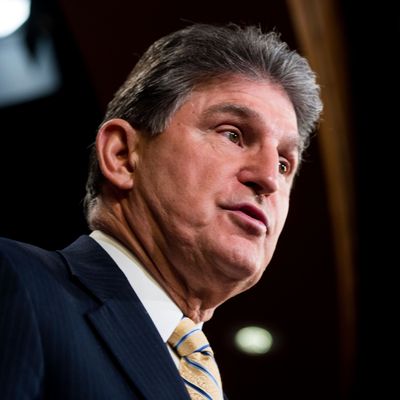
In the first frenetic activity of anti-Trump protests, there are apparently seeds of a more conventionally political movement. One early leader calls it, in a term that will cause shudders among center-left Democrats, a “tea party of the left.”
Now, it could be that such a movement is simply the Bernie Sanders campaign made semipermanent — itself a reflection of a long-standing faction in Democratic politics that believes “economic populism” is the prescription for all seasons. But according to Politico, restive progressives have a very particular and entirely understandable goal that has nothing to do with the campaign that just ended:
“Our big goal is to support primary challenges against those Democrats who negotiate with Donald Trump,” said the organizer, Waleed Shahid, a veteran of Bernie Sanders’ campaign who is working for a group called AllofUs, launched in September.
The first question that must be asked about this agenda is whether Trump and his people need or even want Democrats on the other side of a negotiating table. With a solid majority in the House and a two-vote majority in the Senate (buttressed by the absence of the potentially troublesome heretic Mark Kirk of Illinois), it may not be necessary. If Trump and congressional Republican leaders can come to agreement on a budget reconciliation bill to achieve most of their common goals, from a big upper-end tax cut and more money for the Pentagon to the decimation of low-income programs and the disabling of Obamacare, then they probably will not need a single Democratic vote. Susan Collins and Lisa Murkowski are about the only Republican senators Mitch McConnell would need to worry about, and with Mike Pence breaking tie votes in the Senate, they really don’t matter any more than the Democrats. Yes, all other things being equal, Republicans would prefer securing some Democratic votes for a Trump Supreme Court nominee and an Obamacare replacement plan in order to avoid the messy process of eliminating the Senate filibuster altogether. But it’s not mandatory, and it’s likely that Republicans, fearing midterm House losses in 2018, will want to rush through as much simon-pure conservative legislation as quickly as possible, without screwing around too much with the powerless Democrats.
But it is also possible that Donald Trump personally would like to be able to claim some bipartisan support. The way his cabinet is beginning to shape up, his idea of bipartisanship will probably be the old gibe “Let’s compromise — do it my way.” If down the road Trump has a truly decisive break with congressional Republicans, though, all bets are off. At that point, even the lefty-est of lefty Democrats might support some tactical maneuvering to split the GOP.
So for the time being you have to figure the threat of primarying “traitorous” Democrats is mainly hypothetical and prophylactic. But then the secondary question comes up: Which wavering Democrats are going to be intimidated by a “tea party of the left”?
The obvious targets for either a bipartisan Trump outreach or for disciplinary efforts by progressives are the Democratic senators up for reelection in 2018 who represent states carried by Trump. There are ten of them: Bob Casey (Pennsylvania), Joe Manchin (West Virginia), Bill Nelson (Florida), Sherrod Brown (Ohio), Debbie Stabenow (Michigan), Joe Donnelly (Indiana), Tammy Baldwin (Wisconsin), Claire McCaskill (Missouri), Heidi Heitkamp (North Dakota), and Jon Tester (Montana). You might imagine some of these states are not reliably Republican in the future, but the flip back to the Democrats won’t be automatic, either, in a midterm election when the turnout dynamics have recently favored Republicans.
Now, Sherrod Brown and Tammy Baldwin and probably Debbie Stabenow are not the sort of Democrats who will be hankering for a way to show Trump voters they’re not all bad, and Bob Casey has his own appeal to white working-class voters that doesn’t necessarily depend on bipartisanship. But the rest of these vulnerable Democratic senators could waver.
And if they do, what exactly is “the tea party of the left” going to do about it? Joe Manchin, for one, would probably pay for left-bent protests against his “centrist” heresies in West Virginia, and would definitely welcome a progressive primary opponent to triangulate against. Heitkamp’s state went for Trump by 36 points; Tester’s, McCaskill’s, and Donnelly’s by 20 points or slightly less. Does anyone think a candidate more progressive or partisan than any of these worthies has a prayer of carrying their states in the immediate future?
At some point, would-be members of a “tea party of the left” need to come to grips with the fact that the “tea party of the right” had more geographical material to work with. Trump carried 30 states. So long as every state has two senators, and particularly if the recent trend toward straight-ticket voting persists, it will be difficult for Democrats to control the Senate. Similarly, it will be difficult for Democrats to control a majority of state governments, and that in turn gives Republicans the upper hand in House redistricting. Given that reality, is the biggest problem Democrats face really spinelessness or friendliness with Wall Street? Or is it the absence of candidates and a message that can broaden not just the Democratic popular vote coalition, but its geographical reach?
In the meantime, Democrats should not be surprised if endangered politicians in Trump country choose to “negotiate” instead of defiantly thumbing their noses at their wayward constituents. A national movement of resistance to Donald Trump and all his works may well be the only moral course of action for progressives. But there will be no-shows on the battlefield when the trumpet sounds.






























